Plot
HMS Scorpion, a British submarine that had gone missing in the Baltic Sea during the Second World War, surfaces in the path of a Soviet freighter in 1981. The vessel is returned to British custody. Naval Intelligence is interested in the case because it seems that, for the first time, a ship has returned from "the Devil's Triangle of the North". The submarine opens her own hatch to let the investigating team in, where they find the vessel in a state of perfect preservation, but find no sign of the crew.
Jack Hardy is the only surviving member of the original crew, having been found floating and rescued in 1943 by members of Nazi Germany's Kriegsmarine; but he has no memory of the last days of the 1943 mission. He and Alan Cassidy, one of the vessel's designers, join a Royal Navy crew on a mission to retrace Scorpion's last days before she went missing. Commander Travis, a naval intelligence officer, is in charge of the mission while Captain Byrnes captains the submarine. The mission will take the submarine into Soviet waters while a surface ship, HMS Oakland, escorts the boat. Once in the Baltic, the current crew begins to take on the personalities and identities of the dead crew, and the boat takes a degree of control over herself. Contact with Oakland is soon lost.
A "Soviet submarine" is detected and through communication error the crew fires upon her and destroys her. Scorpion surfaces to search for survivors, but, impossibly, no debris is found. Hardy realises that the "Soviet submarine" was destroyed at the exact same place and time where the Scorpion sank a German U-boat in 1943, and speculates that "the past is breaking through". Cassidy, who had supervised the fitting of the Scorpion with practice torpedoes, finds that they have become live weapons. Captain Byrnes tries to abort the mission, but Cdr Travis convinces him to continue. Hardy learns that the real mission is to discover and exploit the power that preserved and delivered the Scorpion.
Soon, three aircraft are detected on radar whilst the Scorpion is surfaced. The aircraft are Second World War Luftwaffe fighters; Captain Byrnes says in stunned disbelief "This can't be real". Travis pulls out a gun and orders Byrnes below. The fighters then strafe the boat with gunfire. The captain is killed, and Travis takes command. Cassidy and Hardy find no bullet damage on the deck or tower from the strafing attack, and conclude that Travis may have shot the captain to preserve the mission.
Travis apparently becomes possessed by the former captain himself. The original submarine captain's intent had been to torpedo ships of the German fleet in the then German city of Königsberg, which is now the Soviet city of Kaliningrad. Modern Soviet officers detect the incoming hostile vessel, and begin preparations for a nuclear war. Hardy manages to get the crew off the boat before she can attack the Soviet fleet, but Travis and the submarine, essentially as one entity, continue the attack. Hardy rewires the torpedo control system, causing the torpedoes to explode in the torpedo tubes. The explosion kills Travis, and causes the vessel to sink. Hardy is shot in the process. Hardy dies on his bunk, clutching a picture of his wife as the water engulfs him.
Six months later, the Soviets find the sunken Scorpion; and she looks like she has been decaying for forty years. Neither Hardy's nor Travis' bodies are found. The Soviets close their investigation of the incident. British intelligence intercepts the Soviet report, leading British military authorities to also close their files on the case. The British Admiral says "There was no Kaliningrad incident; it never happened. The Scorpion sank in 1943".
Film versus novel
The 1972 book Ghostboat was set in 1974, and revolved around the re-appearance of the Pacific Fleet class Submarine 284 USS Candlefish, thirty years after she disappeared in the Devil's Sea in the Pacific off the Kuriles, toward Japan. The Candlefish surfaces in the path of a Japanese freighter 600 mi (970 km) northwest of Pearl Harbor. The characters and their names remain basically the same (e.g. Alan Cassidy is Walter Cassidy, Travis is Frank Crook) and the mission to re-trace the last days of the Candlefish has no undercurrent of intrigue.
In the original story Candlefish fell through a Geo-magnetic Anomaly (GMA), one of ten, five in the Northern Hemisphere, five in the Southern; and surfaced in the middle of another. The plot is concerned not so much with how the submarine came back, but why she came back.
The final mission of the Candlefish was changed by her captain, to an unplanned entry to Tokyo Bay, in an attempt to sink anything Japanese, and thus acquire a higher figure for tonnage sunk. This falls rapidly apart as the Candlefish sinks, with one survivor – Jack Hardy – injured and washed overboard from the conning tower. As the story concludes, Candlefish risks being unleashed on an unsuspecting Japan in 1974.

U-boats were naval submarines operated by Germany, particularly in the First and Second World Wars. The term is an anglicised version of the German word U-Boot, a shortening of Unterseeboot, though the German term refers to any submarine. Austro-Hungarian Navy submarines were also known as U-boats.

German submarine U-552 was a Type VIIC U-boat built for Nazi Germany's Kriegsmarine for service during World War II. She was laid down on 1 December 1939 at Blohm & Voss in Hamburg as yard number 528, launched on 14 September 1940, and went into service on 4 December 1940. U-552 was nicknamed the Roter Teufel after her mascot of a grinning devil, which was painted on the conning tower. She was one of the more successful of her class, operating for over three years of continual service and sinking or damaging 35 Allied ships with 164,276 GRT and 1,190 tons sunk and 26,910 GRT damaged. She was a member of 21 wolf packs.
German submarine U-571 was a Type VIIC U-boat built for the Kriegsmarine of Nazi Germany for service during World War II. U-571 conducted eleven war patrols, sinking five ships totalling 33,511 gross register tons (GRT), and damaging one other for 11,394 GRT. On 28 January 1944 she was attacked by an Australian-crewed Sunderland aircraft from No. 461 Squadron RAAF west of Ireland and was destroyed by depth charges. All hands were lost.
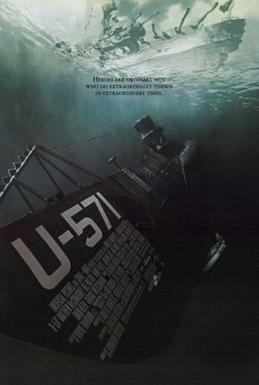
U-571 is a 2000 submarine film directed by Jonathan Mostow from a screenplay he co-wrote with Sam Montgomery and David Ayer. The film stars Matthew McConaughey, Bill Paxton, Harvey Keitel, Jon Bon Jovi, Jake Weber and Matthew Settle. The film follows a World War II German submarine boarded by American submariners to capture her Enigma cipher machine.
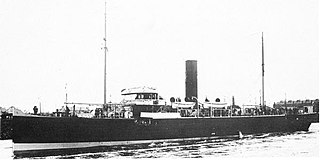
Q-ships, also known as Q-boats, decoy vessels, special service ships, or mystery ships, were heavily armed merchant ships with concealed weaponry, designed to lure submarines into making surface attacks. This gave Q-ships the chance to open fire and sink them. The use of Q-ships contributed to the abandonment of cruiser rules restricting attacks on unarmed merchant ships and to the shift to unrestricted submarine warfare in the 20th century.
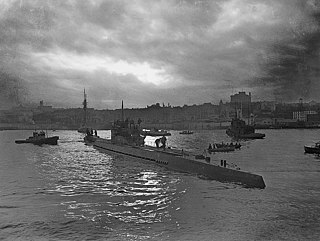
German submarine U-190 was a Type IXC/40 U-boat of Nazi Germany's Kriegsmarine built for service during World War II.

USS Bonefish (SS-223) was a Gato-class submarine, the first United States Navy ship to be named for the bonefish.

USS Scorpion (SSN-589) was a Skipjack-class nuclear-powered submarine that served in the United States Navy, and the sixth vessel, and second submarine, of the U.S. Navy to carry that name.

The submarine film is a subgenre of war film in which the majority of the plot revolves around a submarine below the ocean's surface. Films of this subgenre typically focus on a small but determined crew of submariners battling against enemy submarines or submarine-hunter ships, or against other problems ranging from disputes amongst the crew, threats of mutiny, life-threatening mechanical breakdowns, or the daily difficulties of living on a submarine.

HMS Thetis (N25) was a Group 1 T-class submarine of the Royal Navy which sank during sea trials in Liverpool Bay, England on 1 June 1939. After being salvaged and repaired, the boat was recommissioned as HMS Thunderbolt in 1940. It served during the Second World War until being lost with all hands in the Mediterranean on 14 March 1943.

In Enemy Hands is a 2004 American submarine film directed by Tony Giglio and starring William H. Macy, Til Schweiger, Thomas Kretschmann, Scott Caan and Lauren Holly. The film follows an American submarine crew getting captured by a German submarine crew and taken prisoner aboard their U-boat.

HMS Safari was a third batch S-class submarine built for the Royal Navy during World War II. Commissioned in 1942, she was assigned to operate in the Mediterranean Sea. During the course of the war, Safari sank twenty-five ships, most of which were Italian.
German submarine U-703 was a Type VIIC U-boat of Nazi Germany's Kriegsmarine deployed during the Second World War against allied shipping in the Arctic Ocean. She was a successful boat, which had a far longer service life than most other U-boats, primarily due to the restricted zone of operations in which she fought. Her main mission during the war was to target the Arctic Convoys which carried supplies to the Soviet Union from Britain. At this she was quite successful in her three years of raiding until her presumed demise in 1944.
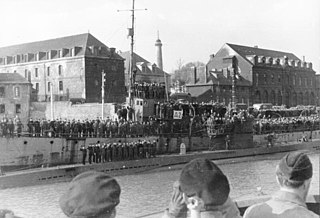
German submarine U-123 was a Type IXB U-boat of Nazi Germany's Kriegsmarine that operated during World War II. After that conflict, she became the French submarine Blaison (Q165) until she was decommissioned on 18 August 1959.
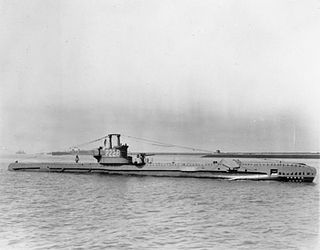
HMS Splendid was a third-batch S-class submarine built for the Royal Navy during World War II. She was laid down on 7 March 1941 and launched on 19 January 1942. After an initial patrol through the Bay of Biscay to Gibraltar, Splendid conducted two patrols in the Mediterranean Sea; one was abandoned after technical problems and on the other she sank two Italian ships. On her next patrol, the submarine attacked two Italian convoys, sinking an Italian destroyer in the second attack. Based in Algiers, the boat operated north of Sicily, sinking six Italian ships, including two tankers and two heavy merchant ships. Splendid was detected by a German destroyer on 21 April 1943 while patrolling off Naples, Italy; the submarine was attacked with depth charges by the destroyer and forced to surface, after which she was scuttled and her surviving crew members taken prisoner. She was the most successful British submarine by tonnage sunk between November 1942 and May 1943.

HMS Sickle was a third-batch S-class submarine built for the Royal Navy during World War II. Completed in 1942, she made her initial war patrol off the Norwegian coast. Sickle then sailed to Gibraltar, from where she conducted one patrol, then to Algiers, French North Africa. From 10 May to 10 October, the boat patrolled the Gulf of Genoa five times and sank a German submarine as well as three minesweepers and an escort ship. She then moved to Beirut, French Lebanon, and conducted two patrols in the Aegean Sea, sinking three caïques and a merchant ship, in addition to landing resistance operatives in Greece.
To Kill the Potemkin (ISBN 978-0917657801) is a novel by Mark Joseph originally published in 1986. As a paperback, it spent four weeks on The New York Times bestseller list in July and August 1987.
German submarine U-198, was a Type IXD2 U-boat which fought in World War II. She was built by the Deschimag DeSchiMAG AG Weser in Bremen. She was laid down on 1 August 1941 as yard number 1044, launched on 15 June 1942 and commissioned on 3 November under Kapitän zur See Werner Hartmann.
I-37, originally numbered I-49, was a Japanese Type B1 submarine in service with the Imperial Japanese Navy during World War II. Commissioned in 1943, she made three war patrols, all in the Indian Ocean, during the last of which her crew committed war crimes by massacring the survivors of the merchant ships she sank. Subsequently, converted into a kaiten manned suicide attack torpedo carrier, she was sunk during her first kaiten mission in 1944.
The Yanagi missions, or more formally the Submarine Missions to Germany, were a series of submarine voyages undertaken by the Imperial Japanese Navy (IJN) during the Second World War, to exchange technology, skills and materials with Japan's Axis partners, principally Nazi Germany. These voyages had to run the gauntlet of the Western Allies naval superiority in the Indian and Atlantic Oceans; of the five westbound voyages, three arrived safely, with two submarines sunk en route, while of the three successful vessels only one completed her return voyage, with two sunk before reaching home.













